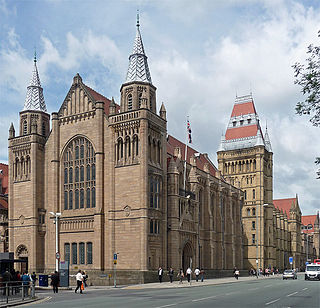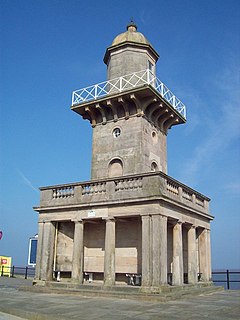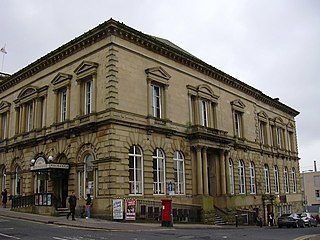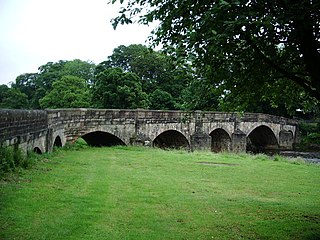
Henry Thomas Hare (1860–1921) was an English architect who was born in Scarborough, Yorkshire and educated in Sheffield and Harrogate.

Simonstone is a small village and civil parish in the Ribble Valley district of Lancashire, England. The population of the civil parish taken at the 2011 census was 1,154. It is about 4 miles (6 km) west of Burnley and south of Pendle Hill and Clitheroe along the A671 road. The village adjoins the village of Read, Lancashire and neighbours Padiham.
Bradshaw Gass & Hope is an English firm of architects founded in 1862 by Jonas James Bradshaw (1837–1912). The style "Bradshaw Gass & Hope" was adopted after J. J. Bradshaw's death and referred to the remaining partners John Bradshaw Gass and Arthur John Hope.

The Whitworth Building is a grade II* listed building on Oxford Road and Burlington Street in Chorlton-on-Medlock, Manchester, England. It has been listed since 18 December 1963 and is part of the University of Manchester. It lies at the south-east range of the old quadrangle of the University, with the Manchester Museum adjoined to the north, and the former Christie Library connected to the west.
This is a list of Grade I listed buildings in Lancashire, England.

Sir James Allanson Picton was an English antiquary and architect who played a large part in the public life of Liverpool. He took a particular interest in the establishment of public libraries.

Fleetwood is a fishing and market town within the Wyre district of Lancashire, England, lying at the northwest corner of the Fylde coast. All of the 44 listed buildings are recorded in the National Heritage List for England at Grade II.

St Saviour's Church is an Anglican chapel in Stydd, a hamlet near Ribchester in Lancashire, England. It has been designated a Grade I listed building by English Heritage.

The Burnley Mechanics is a theatre and former Mechanics' Institute in the market town of Burnley, Lancashire, England. It was built 1854–55 and converted to a theatre in 1979. Historic England has designated the theatre a Grade II* listed building.

James Caldwell Prestwich (1852–1940) was an English architect. He was born in Atherton, Lancashire and educated at Leigh and Nantwich Grammar Schools. He trained to be an architect in London and returned to Leigh in 1875 to start an architectural practice which he worked in until 1930 and which was continued by his son. He produced many buildings in Leigh and Nicholas Pevsner remarked that, "Any building of any merit which is not a church or a mill is almost certainly by the local firm of J.C. Prestwich & Sons, capable – sometimes very capable – in a number of styles."

Lancashire is a county in North West England. In 1974 parts of the historic county were divided between Greater Manchester, Merseyside, Cheshire and Cumbria, and part of the West Riding of Yorkshire was transferred into the county, creating the non-metropolitan county of Lancashire. Together with the unitary authorities of Blackburn with Darwen and Blackpool it now forms the ceremonial county of Lancashire.

There are 48 Grade I listed buildings in Greater Manchester, England. In the United Kingdom, the term listed building refers to a building or other structure officially designated as being of special architectural, historical or cultural significance; Grade I structures are those considered to be "buildings of exceptional interest". In England, the authority for listing under the Planning Act 1990 rests with Historic England, a non-departmental public body sponsored by the Department for Culture, Media and Sport.
Clitheroe is a civil parish in Ribble Valley, Lancashire, England. It contains 117 listed buildings that are recorded in the National Heritage List for England. Of these, one is listed at Grade I, the highest of the three grades, one is at Grade II*, the middle grade, and the others are at Grade II, the lowest grade.
Farnworth is a town and an unparished area in the Metropolitan Borough of Bolton, Greater Manchester, England. It contains 14 listed buildings that are recorded in the National Heritage List for England. All the listed buildings are designated at Grade II, the lowest of the three grades, which is applied to "buildings of national importance and special interest". The area is mainly residential, and the listed buildings include churches and associated structures, two former cotton mills, a railway bridge and a tunnel, a former toll house, a public library, a town hall, a former country house, a war memorial, and a public house.
Ashton-in-Makerfield is a town in the Metropolitan Borough of Wigan, Greater Manchester, England. It contains ten listed buildings that are recorded in the National Heritage List for England. All the listed buildings are designated at Grade II, the lowest of the three grades, which is applied to "buildings of national importance and special interest". Industry, including coal mining, came to the town in the 19th century, but it is now mainly residential. The older listed buildings consist of farmhouses, a farm building, a chapel and a milestone, and the later ones are churches and associated structures, and a library.

The Old Town Hall, sometimes referred to as the Moot Hall, is a municipal building in Church Street, Clitheroe, Lancashire, England. The structure, which was the meeting place of Clitheroe Borough Council, is a Grade II listed building.

Ribchester Bridge is a toll-free, three-span bridge over the River Ribble near Ribchester, Lancashire, England. A Grade II listed structure, located about three quarters of a mile east of the village, it actually crosses the river between the civil parishes of Clayton-le-Dale and Dutton. The bridge carries the two-lane traffic of the B6245 Ribchester Road.

Edisford Bridge is a toll-free, nine-span bridge over the River Ribble near Clitheroe, Lancashire, England. A Grade II listed structure and a Scheduled monument, located about a mile WSW of the centre of town, it crosses the river to the civil parish of Great Mitton. The bridge carries the two-lane traffic of the B6243 Edisford Road.

















